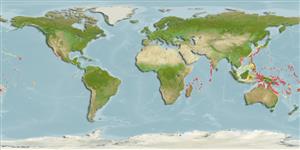分類 / Names
共通名の | 類義語 | Catalog of Fishes(部類, 種) | ITIS | CoL | WoRMS | Cloffa
>
Gobiiformes (Gobies) >
Gobiidae (Gobies) > Gobiinae
Etymology: Eviota: No etymology given, suggested by Christopher Scharpt: from Latin 'eu' for 'true' and 'iota' for anything very small, in combination 'truly very small' referring to it as being the smallest vertebrate at the time it has benn described by Jenkins (thus, making the suggestion by Scharpt plausible.
More on authors: Jewett & Lachner.
Environment: milieu / climate zone / depth range / distribution range
生態学
海 関連する礁; 深さの範囲 3 - 20 m (Ref. 90102). Tropical
Indo-West Pacific: Seychelles to Indonesia, north to Japan (Ogasawara Islands); east to Micronesia and Melanesia to Wallis and Futuna; south to Australia (Western Australia and Great Barrier Reef). The species in the Philippines, Fiji and Tonga is considered E. cf. sigillata.
Length at first maturity / サイズ / 重さ / 年齢
Maturity: Lm 1.3, range 1 - 2 cm
Max length : 3.0 cm SL オス/雌雄の選別がない; (Ref. 48637); 最大記録サイズ: 0.16 年 (Ref. 58013)
背面の脊椎 (合計) : 7; 背鰭 (合計) : 8 - 10; 肛門の骨: 1; 臀鰭: 7 - 8. Characterized by semi-translucent body with irregular, internal reddish midlateral stripe; white stripe along spinal column interrupted by reddish bars that extend ventrally; row of small reddish spots along dorsal midline; usually with narrow reddish bars above anal fin; often prolonged and filamentous first four dorsal spines of male and first three of female; unbranched pectoral rays; longitudinal scale series 21-24; ctenoid scales, absent on head , nape and pectoral fin base; depth of body 4.3-5.0 in SL (Ref. 90102).
Adults live for 59 days at the most, with larvae spending three weeks in the open ocean and maturing within two weeks of settling on a reef, leaving the adults (which are 1 to 2 centimeters long) just three weeks to reproduce. This strategy of 'live fast, die young' is perceived to be a response to intense predation. Daily mortality rate, from tag-recapture data, might be as high as 8% (Ref. 54199). Occur at depths less than 4 to between 17 and 21 m on sandy bottoms of lagoon reefs (Ref. 1602, 37816, 48637). Minimum depth from Ref. 58018. Spawning appears to be repeated on a regular cycle, semilunar or every 14 days (Ref. 116739).
Life cycle and mating behavior
成熟 | 繁殖 | 放精 | 卵 | 生産力 | 幼生
Myers, R.F., 1991. Micronesian reef fishes. Second Ed. Coral Graphics, Barrigada, Guam. 298 p. (Ref. 1602)
IUCNのレッドリストの状況は (Ref. 130435: Version 2024-1)
Human uses
用具
特記事項
XMLをダウンロードして下さい
インターネットの情報源
Estimates based on models
Preferred temperature (Ref.
123201): 24.7 - 29.3, mean 28.1 °C (based on 1837 cells).
Phylogenetic diversity index (Ref.
82804): PD
50 = 0.5000 [Uniqueness, from 0.5 = low to 2.0 = high].
Bayesian length-weight: a=0.00692 (0.00284 - 0.01683), b=3.10 (2.92 - 3.28), in cm total length, based on LWR estimates for this Genus-body shape (Ref.
93245).
栄養段階 (Ref.
69278): 3.1 ±0.3 se; based on size and trophs of closest relatives
Generation time: 0.1 ( na - na) years. Estimated as median ln(3)/K based on 1
growth studies.
回復力 (Ref.
120179): 高い, 15か月以下の倍増期間の最小個体群 (tmax=0.16; Fec = 400 (lifetime)).
Fishing Vulnerability (Ref.
59153): Low vulnerability (10 of 100).
Nutrients (Ref.
124155): Calcium = 3390 [88, 549,132] mg/100g; Iron = 38.8 [1.2, 783.6] mg/100g; Protein = 16.9 [10.7, 23.2] %; Omega3 = 0.0501 [, ] g/100g; Selenium = 2830 [6, 995,074] μg/100g; VitaminA = 0.262 [0.000, 369.350] μg/100g; Zinc = 105 [5, 1,034] mg/100g (wet weight);
